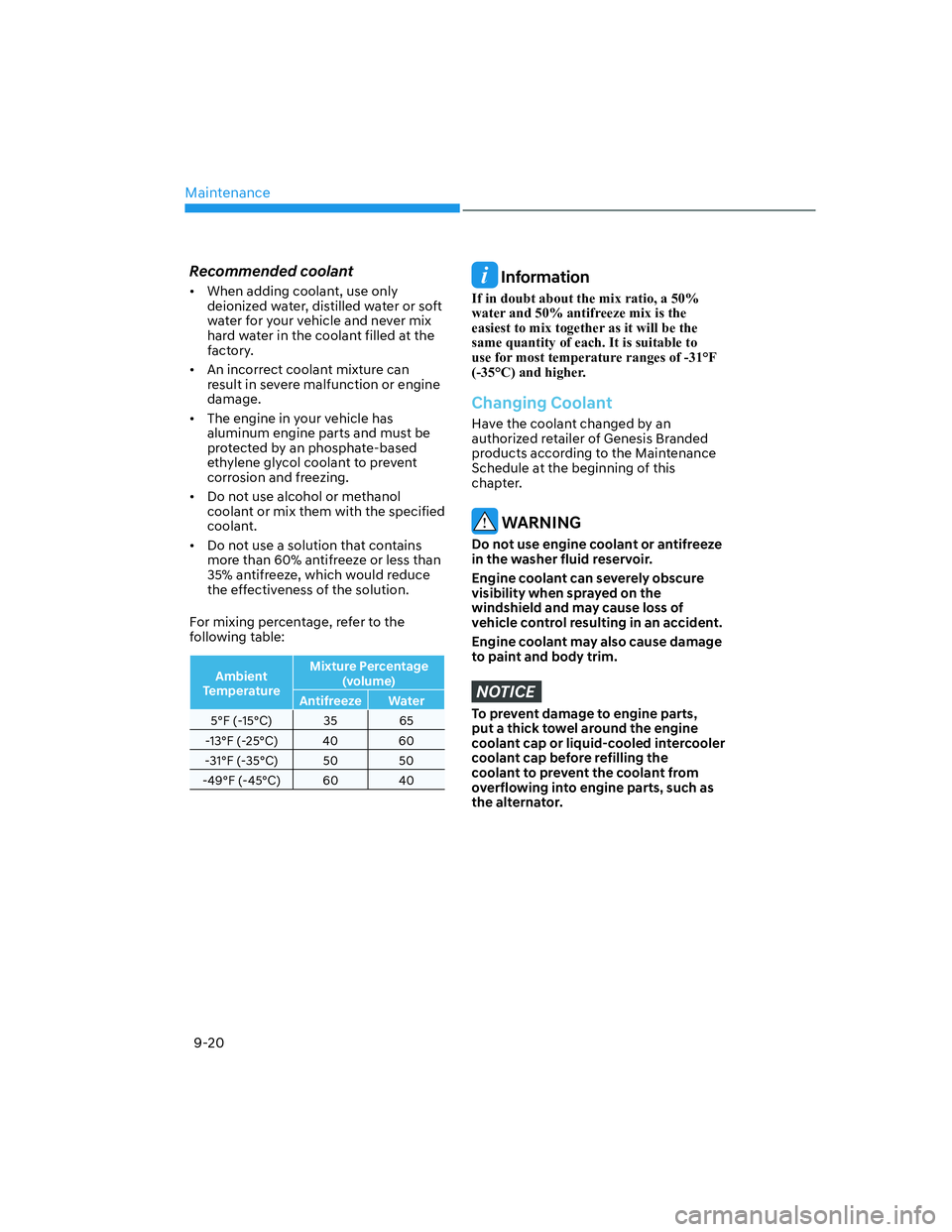2021 HYUNDAI GENESIS GV70 tow
[x] Cancel search: towPage 577 of 647

Maintenance
9-20
Recommended coolant
• When adding coolant, use only
deionized water, distilled water or soft
water for your vehicle and never mix
hard water in the coolant filled at the
factory.
• An incorrect coolant mixture can
result in severe malfunction or engine
damage.
• The engine in your vehicle has
aluminum engine parts and must be
protected by an phosphate-based
ethylene glycol coolant to prevent
corrosion and freezing.
• Do not use alcohol or methanol
coolant or mix them with the specified
coolant.
• Do not use a solution that contains
more than 60% antifreeze or less than
35% antifreeze, which would reduce
the effectiveness of the solution.
For mixing percentage, refer to the
following table:
Ambient
TemperatureMixture Percentage
(volume)
Antifreeze Water
5°F (-15°C) 35 65
-13°F (-25°C) 40 60
-31°F (-35°C) 50 50
-49°F (-45°C) 60 40
Information
If in doubt about the mix ratio, a 50%
water and 50% antifreeze mix is the
easiest to mix together as it will be the
same quantity of each. It is suitable to
use for most temperature ranges of -31°F
(-35°C) and higher.
Changing Coolant
Have the coolant changed by an
authorized retailer of Genesis Branded
products according to the Maintenance
Schedule at the beginning of this
chapter.
WARNING
Do not use engine coolant or antifreeze
in the washer fluid reservoir.
Engine coolant can severely obscure
visibility when sprayed on the
windshield and may cause loss of
vehicle control resulting in an accident.
Engine coolant may also cause damage
to paint and body trim.
NOTICE
To prevent damage to engine parts,
put a thick towel around the engine
coolant cap or liquid-cooled intercooler
coolant cap before refilling the
coolant to prevent the coolant from
overflowing into engine parts, such as
the alternator.
Page 623 of 647

Maintenance
9-66
NOTICE
• Do not use strong soap, chemical
detergents or hot water, and do not
wash the vehicle in direct sunlight
or when the body of the vehicle is
warm.
• Be careful when washing the side
windows of your vehicle.
• Especially, with high-pressure water,
water may leak through the windows
and wet the interior.
• To prevent damage to the plastic
parts, do not clean with chemical
solvents or strong detergents.
NOTICE
OJK090026OJK090026
• Water washing in the engine
compartment including high
pressure water washing may cause
the failure of electrical circuits
located in the engine compartment.
• Never allow water or other liquids
to come in contact with electrical/
electronic components inside the
vehicle as this may damage them.
NOTICE
Matte paint finish vehicle (if equipped)
Automatic car wash which uses rotating
brushes should not be used as this can
damage the surface of your vehicle. A
steam cleaner which washes the vehicle
surface at high temperature may result
the oil to adhere and leave stains that is
difficult to remove.
Use a soft cloth (e.g. microfiber towel
or sponge) when washing your vehicle
and dry with a microfiber towel. When
you hand wash your vehicle, you should
not use a cleaner that finishes with wax.
If the vehicle surface is too dirty (sand,
dirt, dust, contaminant, etc.), clean the
surface with water before washing the
car.
Waxing
A good coat of wax is a barrier between
your paint and contaminate. Keeping
a good coat of wax on your vehicle will
help protect it.
Wax the vehicle when water will no
longer bead on the paint.
Always wash and dry the vehicle before
waxing. Use a good quality liquid or
paste wax, and follow the manufacturer’s
instructions. Wax all metal trim to protect
it and to maintain its luster.
Removing oil, tar, and similar materials
with a spot remover will usually strip the
wax from the finish. Be sure to re-wax
these areas even if the rest of the vehicle
does not yet need waxing.
Page 646 of 647

Index
I-14
Tires and Wheels ........................................................................\
.........................2-10
Tires and Wheels ........................................................................\
.........................9-30
All Season Tires ........................................................................\
......................9-41
Check Tire Inflation Pressure ........................................................................\
..9-31
Low Aspect Ratio Tires ........................................................................\
...........9-43
Radial-Ply Tires ........................................................................\
.......................9-42
Recommended Cold Tire Inflation Pressures ..................................................9-30
Snow Tires ........................................................................\
...............................9-42
Summer Tires ........................................................................\
..........................9-41
Tire Care ........................................................................\
..................................9-30
Tire Maintenance ........................................................................\
.....................9-34
Tire Replacement ........................................................................\
....................9-33
Tire Rotation ........................................................................\
...........................9-32
Tire Sidewall Labeling ........................................................................\
............9-35
Tire Terminology and Definitions ...................................................................9-38
Tire Traction ........................................................................\
............................9-34
Wheel Alignment and Tire Balance ................................................................9-33
Wheel Replacement ........................................................................\
................9-34
Tire Specification and Pressure Label .................................................................2-14
Towing ........................................................................\
.........................................8-20
Emergency Towing........................................................................\
..................8-22
Removable Towing Hook........................................................................\
........8-21
Towing Service ........................................................................\
........................8-20
Trailer Towing ........................................................................\
.............................6-64
Driving with a Trailer ........................................................................\
..............6-67
If You Decide to Pull a Trailer? .......................................................................6-64
Maintenance When Towing a Trailer ..............................................................6-70
Trailer Towing Equipment ........................................................................\
......6-66
V
Vehicle Auto-Shut Off ........................................................................\
.................5-38
Deactivating Conditions ........................................................................\
..........5-38
Operating Conditions ........................................................................\
..............5-38
System Operation ........................................................................\
....................5-38
Vehicle Certification Label ........................................................................\
..........2-14
Vehicle Identification Number (VIN) ..................................................................2-14